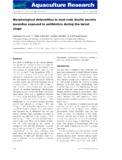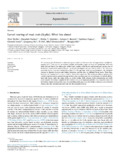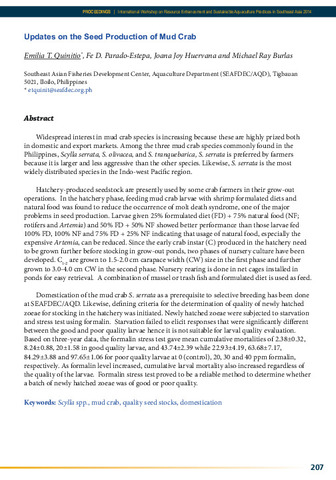Morphological deformities in mud crab Scylla serrata juveniles exposed to antibiotics during the larval stage
Share
Abstract
The effects of antibiotics on the external deformities, growth and survival of mud crab Scylla serrata larvae and juveniles were determined. Zoeae were exposed to oxytetracycline (OTC) (0, 3.0, 6.0, 9.0, 12 mg L-1) and furazolidone (FZD) (0, 0.5, 1.0, 1.5, 2.0 mg L-1) in the first and second experiments, respectively, until the late megalopa. The crab instars were grown in nursery tanks for 1 month. Larvae survived until megalopa only at 3.0 and 6.0 mg L-1 OTC or 0.5 and 1.0 mg L-1 FZD. These four concentrations were run simultaneously in another experiment. Morphological deformities in zoea 5 were bent dorsal, rostral and furcal spines. There was no significant difference (P > 0.05) on the deformities of zoea 5 in 3.0 and 6.0 mg L-1 OTC and 0.5 and 1.0 mg L-1 FZD. Significantly (P < 0.05) higher survival and faster growth were attained in 3.0 mg L-1 OTC and 0.5 mg L-1 FZD. Deformities observed in juveniles were fused frontal and lateral spines, asymmetrical and depressed tip of abdominal flap and gap between sternites. High percentage occurrence of deformities was observed in the 6.0 mg L-1 OTC and 1.0 mg L-1 FZD in the first and third experiments, respectively. There was no significant difference (P > 0.05) observed in the survival of juveniles in OTC and FZD treatments. However, growth was significantly (P < 0.05) faster in lower concentrations of the two antibiotics. The study shows the effects of OTC and FZD in the morphology of mud crab. Therefore, there is a need to eliminate the use of antibiotics and find alternatives.
Suggested Citation
Pates, G. S., Jr., Quinitio, E. T., & Parado-Estepa, F. D. (2017). Morphological deformities in mud crab Scylla serrata juveniles exposed to antibiotics during the larval stage. Aquaculture Research , 48(5), 2102-2112. https://doi.org/10.1111/are.13046
Subject
Taxonomic term
Collections
- AQD Journal Articles [1249]
Related items
Showing items related by title, author, creator and subject.
-
Larval rearing of mud crab (Scylla): What lies ahead
Waiho, Khor; Fazhan, Hanafiah; Quinitio, Emilia T.; Baylon, Juliana C.; Fujaya, Yushinta; Azmie, Ghazali; Wu, Qingyang; Shi, Xi; Ikhwanuddin, Mhd; Ma, Hongyu (Elsevier, 2018)The increasing global demand for mud crabs (genus Scylla) and threats to the wild populations highlight the urgency of fully rearing them in captivity. Despite considerable progress in mud crab production, most crab farms ... -
Mud crab pond and pen culture
Rodriguez, Eduard M. (University of the Philippines Aquaculture Society, Inc, 2001) -
Updates on the seed production of mud crab
Quinitio, Emilia T.; Parado-Estepa, Fe D.; Huervana, Joana Joy; Burlas, Michael Ray (Aquaculture Department, Southeast Asian Fisheries Development Center, 2015)Widespread interest in mud crab species is increasing because these are highly prized both in domestic and export markets. Among the three mud crab species commonly found in the Philippines, Scylla serrata, S. olivacea, ...




